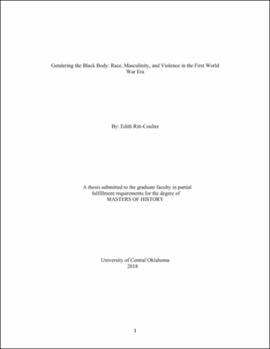| dc.contributor.advisor | Churchill, Lindsey Blake | |
| dc.contributor.author | Ritt-Coulter, Edith | |
| dc.date.accessioned | 2020-07-09T14:41:06Z | |
| dc.date.available | 2020-07-09T14:41:06Z | |
| dc.date.issued | 2018 | |
| dc.identifier.other | (AlmaMMSId)9982594884702196 | |
| dc.identifier.uri | https://hdl.handle.net/11244/325115 | |
| dc.description.abstract | This thesis examines the phenomena of lynching through the lens of gender and identity by exploring social constructions of black masculinity in the United States. The US lynching culture that emerged in the late nineteenth and early twentieth century specifically targeted black men based on notions of acceptable masculine behavior. Mainstream society characterized black masculinity as subservient to their white counterparts and restricted them into narrow ideas of gender performance. During the First World War, African American culture experienced a revitalization of political consciousness and identity, which challenged the hegemony of white men. Lynching became a tool to police liberated black masculine identity and to regulate the societal performance thereof. Using rarely utilized archival material, located in Omaha, Nebraska and Houston, Texas, this work studies the cases of Bert Smith and William Brown as examples of the physical manifestation gendered violence committed against African American men. Several key events contributed to the challenging of the established racial hierarchy including the Great Migration, African American military service, and the rise of Black Nationalist organizations. The significant cultural shift of this period created racial tension that was rooted in ideas of gender identity. I argue that the increase in lynchings during and after the First World War is the direct result perceived challenges to hegemonic white masculinity. Further, my work demonstrates that black acts of liberation were met with gendered violence in the form of lynching as an attempt to control African American men's defiance of white notions of acceptable masculine behavior. My work contributes to the field of lynching studies because it goes beyond the established examination of African American men's sexuality. My thesis adopts an intersectional approach through which historians can further dissect the influence of race, gender, and identity on acts of violence committed against the black community in the United States. | |
| dc.rights | All rights reserved by the author, who has granted UCO Chambers Library the non-exclusive right to share this material in its online repositories. Contact UCO Chambers Library's Digital Initiatives Working Group at diwg@uco.edu for the permission policy on the use, reproduction or distribution of this material. | |
| dc.subject.lcsh | African American men | |
| dc.subject.lcsh | Lynching | |
| dc.subject.lcsh | Masculinity | |
| dc.title | Gendering the black body : race, masculinity, and violence in the First World War era. | |
| dc.type | Academic theses | |
| dc.contributor.committeeMember | Goulding, Marc | |
| dc.contributor.committeeMember | Huneke, Erik | |
| dc.thesis.degree | M.A., History | |
| dc.subject.keywords | Black masculinity | |
| dc.subject.keywords | Lynching | |
| dc.identifier.oclc | (OCoLC)1041735102 | |
| uco.group | UCO - Graduate Works and Theses::UCO - Theses | |
| thesis.degree.grantor | Jackson College of Graduate Studies. | |
